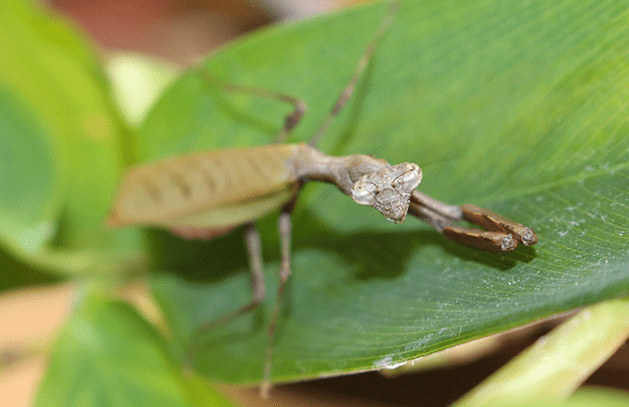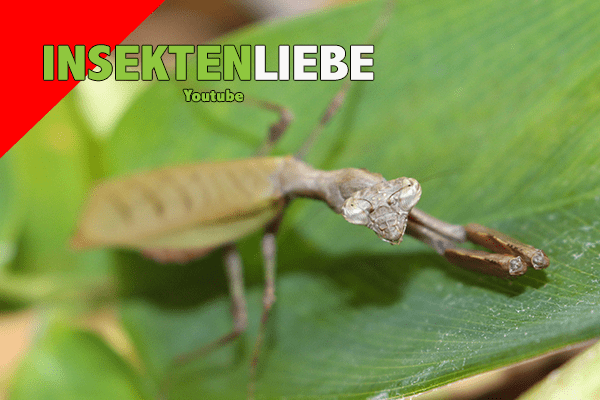General Information
Acromantis japonica are very fascinating praying mantises that show the boxing typical for boxer mantids with their tentacles in case of danger. This is done by alternately moving the tentacles forward in a circular motion and retracting them again, making them look like they are in a boxing match. This makes the inside of the tentacle visible. The Japanese Boxermantis shows a low intraspecific aggressiveness. Thus, cannibalism rarely occurs and they are well suited for group housing. Also during mating, thanks to the boxer behavior, cannibalism is rare and the male often stays on the female after mating, to mate again after some time. The so-called boxer behavior is used for communication of this very interesting mantid species.
Size:
Male: 3.0 cm
female: 3,5 cm
Very nice small-bodied species that can be easily housed in any home and are very suitable for beginners.
Food:
I feed the animals every 2-3 days. As nymphs I feed them about 4-6 fruit flies. Adult females can eat 2 to 3 blowflies. Adult males 1 to two gold flies. I have not noticed this species becoming overweight or obese as they simply do not accept food before.
L1/L2: springtails Collembola or freshly hatched
ovenfish Thermobia domestica
L3/L4: small fruit flies Drosophila melanogaster
L5/L6: large fruit flies Drosophila hydei
L7/adult: blowflies Calliphora sp. or adult
Ovenfish Thermobia domestica
The males take flesh flies as subadults, and prefer the slightly smaller gold flies as adults. They like to wait for prey, but will occasionally go active.
Habitat:
Acromantis japonica is found in Japan, Korea, Taiwan and adjacent eastern China. There they live mainly in bushes and on trees. Although it is a tropical species, the room temperature of 22°C does not seem to slow down its growth. Also as far as humidity is concerned, it is actually rather atypical for a tropical species. 60-70% during the day, 10% higher at night. I spray once a day, half an hour before the lights go out.
Insectarium husbandry:
L1/L2:
L1 nymphs are black and look like small ants. Their legs have bands of alternating hue. Nymphs are very active, they love to run around everywhere. Later as adults they are content to hang motionless from a stick or their case lid. I keep them in groups at this stage in a 500 ml plastic box. I cut an opening in the lid and put a lady stocking underneath. In the beginning I use untreated wood wool as climbing material and fine clay granules as substrate. With this species I do not use springtails, because it seems that they are stressed by them. There must always be twice the size of the mantids at the bottom, so that the moulting can proceed smoothly. In the evening I spray the cup so that it is dry the next evening. When spraying, it is better to start a little more carefully and approach slowly. Waterlogging is more dangerous for your animal like a little lower humidity. There should always be enough Drosophilas in the container so they don’t eat each other.
L3/L4:
When startled they run or jump very fast at this age to escape. I isolate the animals from pre-subadult (2 more molts to adult). I use either cricket tins, set up on edge or 500ml plastic tins. There should be branches like in their natural environment. If you take branches from nature, put them in the microwave for 20 seconds or in the oven at 100°C for 15 minutes beforehand. This will kill all the mites and other parasites that you bring with you and that can cause you problems later. Also there the motto is, less is more. Acromantis japonica are lurking hunters, you should not pack it full. Leave space for molting, as this moment is the most dangerous time in your guest’s life.
Reproduction:
Sex determination:
First of all, we need to know what is a female and what is a male.
In all mantid species, females can be distinguished from males by the number of visible abdominal segments (sternites).
Males have 8 sternites, but females have only 6 visible ones. In this very small species I recognize the sex difference in the pre-subadult stage. Usually it is also enough to look only at the last segment on the abdomen. If it is as long and wide as the previous segments, they are females. If the last segments become progressively smaller and narrower, it is a male.
Sexual maturity:
I look for the wing attachments. If those are about 1/3 the length of the later wings, then the following molt is the adult molt. Females become adults after about 8 molts, thus in L9. Male Japanese Boxermantis after 7 molts, thus in L8. Mantids take about 3 weeks to become ready to mate after the mature molt. Overall, the life span includes about 10-12 months for females and 7-8 months for males.
Mating:
To mate Acromantis japonica, I transfer them to a large BraPlast box with plenty of branches and hiding places. Before that I give the female a large food animal so that she is busy eating during the mating and does not attack the male. This reduces sexual cannibalism and at the same time provides better ootheca. Mating proceeds as follows. The male jumps on the female’s back while holding her with his front legs. Copulation can last up to 12 hours, so you can watch the spectacle at your leisure. Mating is quite unproblematic with Acromantis japonica, nevertheless I would not do without the mentioned precautions. Life expectancy after adult molt is about 4-6 months. If breeding does not work, I increase the temperature of the breeding tank to about 27°C, this increases the willingness to mate.
Here you can observe a meeting of the both sexes.
Oothec deposition:
2 weeks after mating the first ootheca is laid. For this purpose I put additional branches into the insectarium. Very gladly branch forks are used for the deposit. The oothecae have a light to dark brown coloration, are about 5mm wide and have a length of 1,5cm to 2,5cm. At temperatures around 24°C 20-50 nymphs hatch after 30 days. More about ootheca can be found here.
Incubation:
Hatching is strongly coupled to temperature and humidity- at 29°C and 70% humidity the 4mm sized hatchlings will hatch after about 5 weeks. Please feed the hatchlings immediately after hatching, this will reduce cannibalism significantly.




